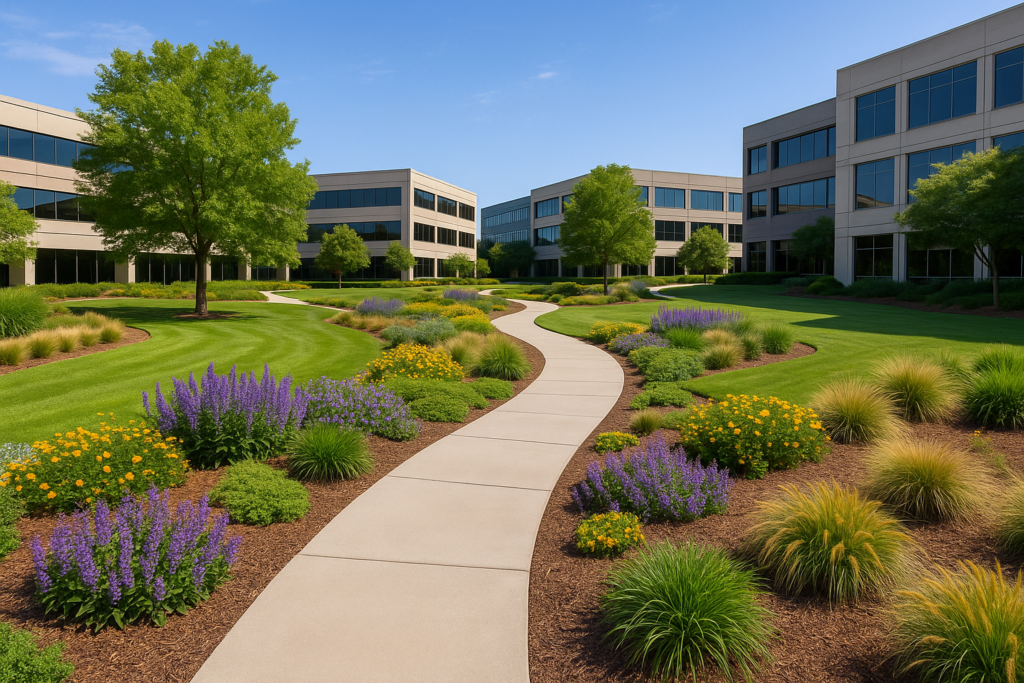Designing a beautiful landscape for multi-building campuses requires more than planting trees and placing benches. It’s a sophisticated blend of form and function, connecting buildings, people, and nature through intentional landscape design architecture. A well-executed layout creates a unified environment that fosters wellness, enhances brand identity, and supports both functionality and sustainability.
This guide provides expert insights to help businesses, institutions, and developers plan and implement effective beautiful landscape applications across multi-structure properties.
Why Multi-Building Campus Landscapes Matter
Unifying Separate Spaces
Multiple buildings often create physical and visual fragmentation. A cohesive landscape design serves as the connective tissue, transforming disjointed structures into a unified campus experience.
Enhancing Navigation and Flow
Clear walkways, visual cues, and intuitive spatial arrangements ensure that employees, visitors, and students can move seamlessly between buildings.
Reinforcing Brand Identity
From plant choices to layout symmetry and signage integration, the landscape can mirror a brand’s values—whether they emphasize innovation, sustainability, luxury, or wellness.
Core Components of Effective Landscape Layouts
Master Landscape Drawing
A comprehensive landscape drawing is essential for multi-building campuses. It maps out plant zones, irrigation systems, lighting grids, circulation routes, gathering areas, and sustainability features.
Zoning with Purpose
Organize the campus into functional zones:
- Social zones: Courtyards, patios, outdoor meeting areas
- Transit zones: Walkways, driveways, bike paths
- Wellness zones: Meditation gardens, fitness loops, shaded trails
- Utility zones: Maintenance access, stormwater management, equipment storage
Wayfinding and Signage
Blend signage naturally into the landscape using sustainable materials. Pathway design and sightlines should help direct movement without excessive signage clutter.
Creating Connectivity Through Walkways and Trails
Walkways are the arteries of a multi-building campus. They guide movement, frame green spaces, and encourage physical activity.
- Use permeable materials to support stormwater control
- Line pathways with native plants and shade trees for beauty and comfort
- Include subtle lighting for safety and nighttime usability
Explore walkway strategies in Beautiful Landscape Walkways That Inspire Daily Movement.
Supporting Outdoor Work and Meetings
Modern campuses must serve the needs of hybrid and flexible work models. Landscape layouts should integrate:
- Outdoor meeting pods with shade and power access
- Multi-use patios and café-style seating
- Collaboration zones with writable surfaces or amphitheater-style seating
For more ideas, see Beautiful Landscape Zones That Encourage Outdoor Meetings.
Prioritizing Beautiful Landscape Sustainability
Native and Adaptive Planting
Choose regionally appropriate plants that require minimal water and maintenance, contributing to a sustainable and cost-effective design.
Smart Irrigation and Drainage
Use drip irrigation and rain sensors to avoid water waste. Incorporate bioswales and rain gardens to manage stormwater.
Renewable and Recycled Materials
Select low-impact, recycled, or locally sourced materials for benches, paving, signage, and structures.
Energy-Efficient Lighting
Solar-powered and LED lighting systems illuminate walkways and key features without increasing energy demand. See examples in Beautiful Landscape Lighting Ideas for Corporate Campuses.
Designing for Engagement and Wellness
Beautiful landscapes are not just for aesthetics—they encourage movement, mindfulness, and connection with nature.
- Include sensory gardens or pollinator gardens that attract bees and butterflies
- Provide shaded walking loops and fitness circuits
- Add calming water features or reflective pools
- Use natural elements like stone, wood, and gravel to ground users in the environment
Collaboration with Landscape Contractors
Site Analysis and Strategy
Experienced landscape contractors begin with a thorough site assessment to identify soil types, grading, water flow, and existing vegetation.
Phased Development Planning
Large campuses benefit from phased landscape development that aligns with construction timelines and budget availability.
Long-Term Maintenance Planning
A comprehensive maintenance plan ensures that landscapes remain vibrant, safe, and inviting year-round. Contractors can provide seasonal care schedules and sustainability audits.
Real-World Layout Considerations
- Position seating and work areas near building entrances for quick access
- Create pedestrian-only zones to minimize traffic interference
- Integrate lighting with landscape contours to avoid glare and overexposure
- Design outdoor dining areas with wind and sun protection in mind
Final Thoughts
Designing a beautiful landscape for multi-building campuses requires intentionality, vision, and professional guidance. From creating clear circulation routes to integrating sustainable practices, every element must work in harmony to foster functionality and beauty.
With expert landscape contractors, detailed landscape drawings, and a commitment to landscape design architecture, your campus can inspire movement, collaboration, and connection at every turn.
A well-crafted landscape layout is more than a visual upgrade—it’s a long-term investment in the people and purpose of the property.

